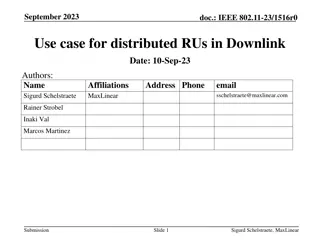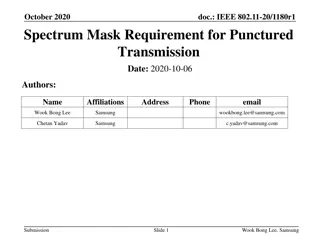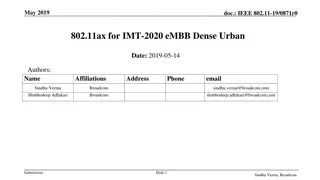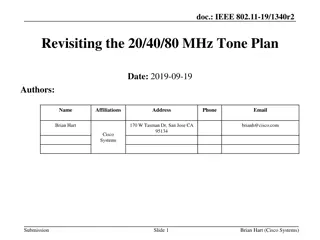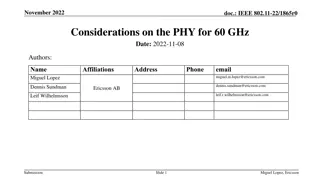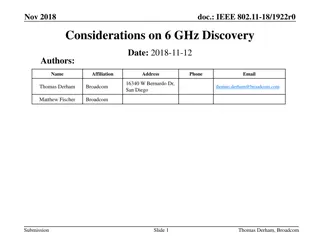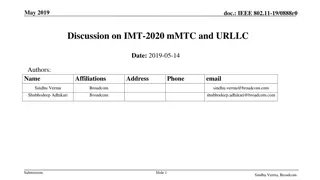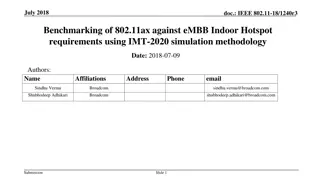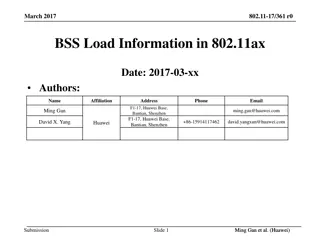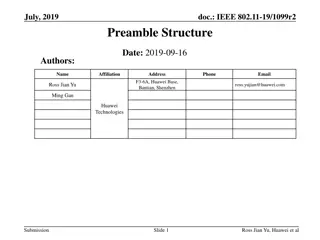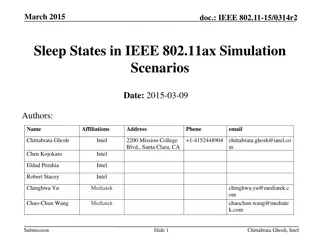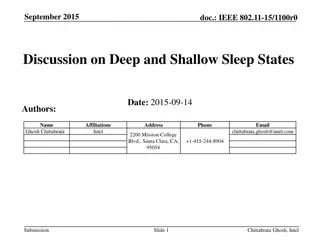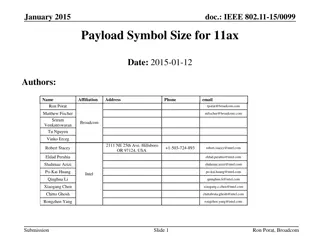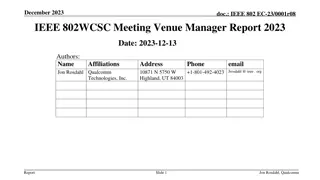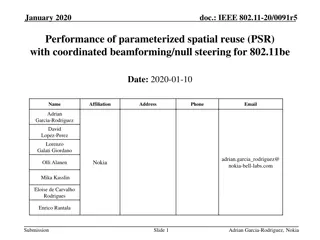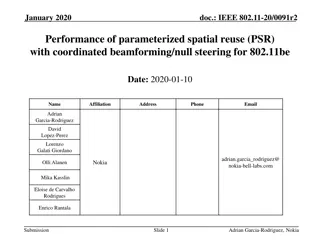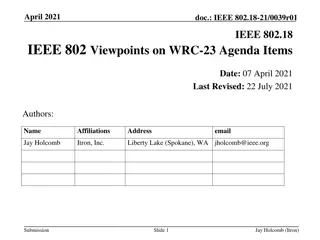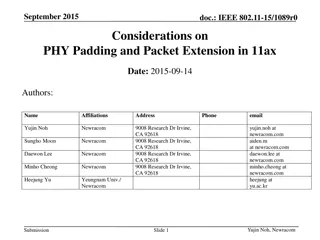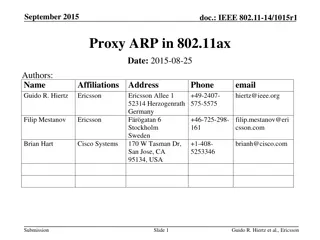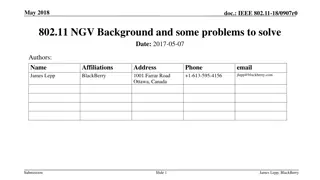Proposed Approach for MAC Address Assignment in IEEE 802.11
IEEE 802.1CQ is working on a mechanism to assign local MAC address blocks to end nodes specifically related to IEEE 802.11 standards. The current draft lacks a pre-association mechanism for IEEE 802.11 stations to obtain a local MAC address before association. The proposed remedy suggests specifying
6 views • 7 slides
IEEE 802.11-23/2092r2 AIML Report Summary
This document conveys the findings of the AIML Technical Report for IEEE 802.11 networks. It covers AIML use cases in WLANs, performance enhancement opportunities, IEEE 802.11 feature requirements, standard impacts, and proposed next steps for AIML integration. AIML's significance in various technol
3 views • 17 slides
Proposal for Random Access Efficiency Enhancement in IEEE 802.11be Networks
This document presents a proposal for enhancing random access efficiency in IEEE 802.11be networks through a Random-Access NFRP (RA-NFRP) principle. The proposal addresses the challenges of low efficiency in the current UORA procedure and introduces modifications based on the 802.11ax standard to im
5 views • 16 slides
Use Case for Distributed Resource Units in Downlink Scenarios
The document explores the concept of distributed Resource Units (dRU) in downlink scenarios in IEEE 802.11 standards like 802.11ax and 802.11be. It discusses the benefits and potential advantages of using dRU in downlink transmissions, focusing on how it can effectively distribute tones across the s
3 views • 13 slides
Discussion on IEEE 802.11be MLD Architecture Alignment
IEEE 802.11 TGbe is exploring MLDs within the 802 architecture, focusing on aligning MLD operations with existing 802.11 features for enhanced compatibility. The MLD architecture aims to facilitate the flow of data between MAC SAPs and PHY SAPs, extending the current framework for APs and non-AP STA
1 views • 23 slides
Spectrum Mask Requirements in IEEE 802.11 for Punctured Transmission
The document discusses the spectrum mask requirements for punctured transmission in IEEE 802.11 standards, specifically focusing on differences between ETSI and IEEE 802.11ax spectral masks. It covers cases of puncturing scenarios and additional channel edge masks to be applied in different situatio
1 views • 16 slides
IEEE 802.11-23-1689r1 Vice Chair Report - November 2023 Plenary Session
The document presents the Vice Chair report by Jon Rosdahl from Qualcomm at the IEEE 802.11-23-1689r1 meeting in Honolulu on November 17, 2023. It covers agenda items, session information, meeting logistics, successful meeting protocols, and important event summaries. Additionally, it provides detai
1 views • 25 slides
IEEE 802.11-20/0021-00 Priority Access Support for NS/EP Services Overview
This document discusses the importance of priority access support in IEEE 802.11be for National Security and Emergency Preparedness (NS/EP) services. It outlines the need for standardized mechanisms to ensure priority services in WLAN networks during NS/EP events when cellular coverage is unavailabl
1 views • 15 slides
802.11ax Evaluation for IMT-2020 eMBB in Dense Urban Environments
The document presents a detailed analysis of the 802.11ax technology's performance in meeting IMT-2020 requirements for eMBB in dense urban settings. It includes results from simulations evaluating peak spectral efficiency, data rates, user experience, and mobility metrics. The study confirms 802.11
0 views • 14 slides
Evaluation of IEEE 802.11ax for IMT-2020 eMBB Dense Urban Test Environment
This document discusses the evaluation of IEEE 802.11ax technology in the context of the IMT-2020 Enhanced Mobile Broadband (eMBB) Dense Urban test environment. It analyzes the performance of 802.11ax in meeting the key PHY/MAC metrics required for eMBB Dense Urban scenarios, such as Peak Spectral E
2 views • 13 slides
IEEE 802.11-19-0202/r1 TGbd Agreed Terminology and Requirements
This document outlines the agreed terminology and requirements for the development of the next generation of IEEE 802.11p technology within IEEE 802.11bd Task Group. It covers aspects such as interoperability, co-existence, backward compatibility, and fairness between IEEE 802.11p and IEEE 802.11bd
0 views • 6 slides
Revisiting the IEEE 802.11-19/1340r2 Tone Plan Optimization
Revisiting the tone plan optimization for IEEE 802.11-19/1340r2, addressing issues with RUs near band edges, accommodating various STA bandwidth capabilities, and the inefficiencies of non-SST 11ax STAs in different BSS scenarios. Proposals include adapting to unknown future 11ax features, minimizin
5 views • 12 slides
Analyzing and Improving Latency in IEEE 802.11 Networks
The document discusses controlling latency in IEEE 802.11 networks to meet the demands of emerging applications that require not only high throughput but also low latency. It covers aspects such as latency analysis, potential improvements, latency vs. reliability trade-offs, and latency improvement
4 views • 14 slides
Considerations on PHY for 60 GHz in IEEE 802.11-22/1865r0 Document
The document discusses the possibility of standardizing multi-link (ML) with bands in the sub-7 GHz range combined with bands in the 45-72 GHz range, proposing reusing a sub-7 GHz PHY for mmWave bands. It explores the impact of phase noise on choosing the OFDM numerology for operation in the 45-72 G
1 views • 13 slides
Wireless TSN in 802.11: New Requirements and Integration with 802.1
This document discusses the extension of TSN capabilities from wired to wireless networks, focusing on potential enhancements for 802.11be and integration with Ethernet-based TSN standards. It covers topics such as time-sensitive applications, TSN toolbox overview, status of TSN capabilities support
4 views • 12 slides
Considerations on 6 GHz Discovery for IEEE 802.11-18/1922r0
IEEE 802.11-18/1922r0 document discusses the background and regulatory context for supporting 6 GHz operation in 802.11ax networks. It focuses on optimizing the discovery process for 6 GHz channels to enhance STA and network KPIs. The typical scanning/discovery procedure for non-AP STAs is outlined,
2 views • 14 slides
Modulation Schemes for IEEE 802.11bd Range Extension
The document discusses modulation schemes for extending the range in IEEE 802.11bd, aiming for at least 3dB lower sensitivity levels. It highlights the need for an implementation-friendly, proven technology already adopted in IEEE 802.11. The introduction of the MCS0 DCM scheme in 11ax is also cover
0 views • 15 slides
LDPC Investigation for IEEE 802.11bd Technology in March 2019
In March 2019, the document IEEE 802.11-19/0346r3 delves into the investigation of LDPC (Low-Density Parity-Check) codes for the advancement of 11bd technology. The authors from Marvell explore the potential benefits of LDPC over BCC (Block Code Concatenation) in achieving better sensitivity for 802
0 views • 15 slides
Evolution of Standards: IEEE 802.11 and 802.1D Relationship
Explore the relationship between IEEE 802.11 and 802.1D standards, discussing the necessity of referencing old standards, the state of 802.1D, and the potential for removing outdated references in 802.11. The submission proposes a migration model while emphasizing the importance of staying current w
0 views • 42 slides
IEEE Std. 802.11-22/1017r0 Overview and Architecture Presentation
This presentation by Dorothy Stanley from HP Enterprise delves into the utilization of IEEE Std. 802.11-2020 standards focusing on the IEEE Std. 802 overview and architecture. It covers topics such as the use of LLC, MAC address formats, QoS mechanisms, MSDU formats, and various MAC services and pro
0 views • 10 slides
Analytical Evaluation of IMT-2020 mMTC and URLLC Requirements in IEEE 802.11-19/0888r0
This contribution analyzes the IMT-2020 mMTC and URLLC requirements in IEEE 802.11-19/0888r0, evaluating the capabilities of 802.11ax technology in meeting these demands. It discusses key aspects such as connection density, message size, delay per user, evaluation scenarios, system configurations, S
0 views • 9 slides
Benchmarking of 802.11ax for eMBB Indoor Hotspot Using IMT-2020 Simulation Methodology
This presentation continues the benchmarking of 802.11ax capabilities concerning IMT-2020 requirements for eMBB Indoor Hotspot and Dense Urban test environments. The simulations cover UL, mobility aspects, and adherence to ITU-R methodology. Analytical evaluations and simulation results demonstrate
0 views • 16 slides
Enhancing BSS Load Management in 802.11ax Networks
Proposed changes to address load balancing issues in dense 802.11ax scenarios by introducing a new information element for BSS Load. The new element considers OFDMA utilization, UL/DL MU-MIMO, and allows for future extensions to ensure efficient AP selection by unassociated STAs. Enhancements aim to
0 views • 14 slides
IEEE-SA Fellowship Program at IEEE 802 Plenary March 2019 Schedule
The IEEE-SA Fellowship Program at the IEEE 802 Plenary in March 2019 featured key participants like Jodi Haasz, Glenn Parsons, and other industry experts from various countries. The program included sessions on IEEE standards development processes, newcomer orientation, working group meetings, techn
0 views • 9 slides
IEEE-SA Fellowship Program at IEEE 802 Plenary March 2018
The IEEE-SA Fellowship Program at the IEEE 802 Plenary in March 2018 featured notable participants like Glenn Parsons, Jodi Haasz, Richard Anago, Lloyd Matabishi, Rudo Mudavanhu, and Yvonne Umutoni, among others. The program included a schedule covering various sessions such as an introduction to IE
0 views • 9 slides
IEEE 802.11-19/1099r2 Preamble Structure Overview
The document discusses the specific preamble structures of IEEE standards such as 802.11n, 802.11ac, and the newer 802.11ax (11ax). It explores the functionalities provided by these preambles including synchronization, auto-detection, channel estimation, and more. The focus is on how different stand
0 views • 13 slides
Power Consumption and Latency in IEEE 802.11ax State Transitions
This document discusses power consumption and latency values in state transitions for IEEE 802.11ax simulation scenarios. It covers power states definition, common power model parameters, and state transitions within the simulation scenarios. The transitions include Transmit to Listen, Receive to Li
0 views • 9 slides
IEEE 802.11ax Sleep States Analysis
This document delves into the analysis of sleep states in IEEE 802.11ax, emphasizing the need for refining current sleep state definitions to adhere to network conditions. It proposes various sleep states modifications to accommodate densification and low power operations, aiming to strike a balance
0 views • 12 slides
Discussion on Power State Definitions in IEEE 802.11ax
This document discusses the power state definitions in IEEE 802.11ax, focusing on Deep Sleep and Shallow Sleep states. It addresses the current consumption values and proposes modifications to enhance the clarity of power state definitions and transitions. The author, Chittabrata Ghosh from Intel, p
0 views • 13 slides
IEEE 802.11-15/1306r0 Use Cases for LRLP and Full Function in STA
The documents related to IEEE 802.11-15/1306r0 explore various use cases for LRLP (Low-Rate Longevity-Performance) and full functional capabilities in Single Terminal Architecture (STA). Tim Godfrey from EPRI presents scenarios where AP/STA pairings with 802.11ax and LRLP are approved and deployed,
0 views • 7 slides
IEEE 802.11-15/0099 Payload Symbol Size for 11ax Study
The document dated January 2015 discusses the payload symbol size for 11ax in IEEE 802.11 standards. It includes contributions from various authors representing companies like Broadcom, Intel, Samsung, Marvell, and NTT. The study addresses technical aspects related to wireless communication technolo
0 views • 33 slides
IEEE 802.1CQ: Address Assignment and Validation Protocols
This document explores the assignment and validation of unicast addresses within IEEE 802 networks, emphasizing the need for uniqueness to prevent operational errors and security breaches. It discusses the challenges of ensuring globally-unique addresses, proposing the implementation of a single val
0 views • 6 slides
IEEE 802 Wireless Meeting Venue Reports and Future Plenary Contracts Update
Jon Rosdahl from Qualcomm provided updates on the current status of 802 Wireless Interim Session venue plans, a recap of 802 Executive Committee decisions, and future 802 Plenary venue contract statuses up to 2027. The presentation highlighted selected venues, open dates, and upcoming contracts for
0 views • 56 slides
Performance Evaluation of Parameterized Spatial Reuse with Coordinated Beamforming for IEEE 802.11be
The study focuses on assessing the performance of parameterized spatial reuse (PSR) with coordinated beamforming/null steering for IEEE 802.11be. The framework allows coordinated sharing of uplink transmission opportunities among APs, demonstrating gains in synchronous coordinated beamforming system
0 views • 19 slides
Performance Evaluation of Coordinated Beamforming with Parameterized Spatial Reuse in IEEE 802.11be
The document discusses the performance evaluation of coordinated beamforming with parameterized spatial reuse (PSR) in IEEE 802.11be. It explores the practical operation of the 802.11ax PSR framework with null steering and the key implementation benefits, emphasizing unsynchronized operation and ada
0 views • 20 slides
Suitability of IEEE 802.11ah for LPWAN Applications Analysis
This document analyzes the suitability of IEEE 802.11ah for Low Power Wide Area Network (LPWAN) applications. It examines the features of IEEE 802.11ah, such as OFDM-based FEC and its performance in fulfilling LP-WAN use-cases. The document also discusses channel models, interference resistance, and
0 views • 22 slides
IEEE 802 Viewpoints on WRC-23 Agenda Items
This document presents IEEE 802's viewpoints on Agenda Items related to current IEEE 802 standards activities for the WRC-23. It reflects the perspectives of IEEE 802 and provides insights on various AI topics such as frequency bands and IMT multiple bands. The document offers analysis and considera
0 views • 9 slides
Considerations on PHY Padding and Packet Extension in 11ax
The document discusses the proposed PHY padding and packet extension for IEEE 802.11ax, focusing on considerations for processing data within SIFS duration and relaxation of LDPC decoding processing time. It outlines the overview of the proposed padding scheme, considerations for LDPC implementation
0 views • 15 slides
Understanding Proxy ARP Implementation in IEEE 802.11ax
Proposed in September 2015, the document discusses the implementation of Proxy ARP with 802.11ax Access Points. It explains the Address Resolution Protocol (ARP), detailing how devices in a LAN communicate using MAC and IP addresses. The submission aims to provide comprehensive explanations on Proxy
0 views • 18 slides
Challenges and Proposed Solutions in Next-Generation Vehicle Technologies
The document discusses the background of IEEE 802.11 NGV technologies, focusing on the need for a new 10 MHz PHY for DSRC systems. It highlights issues related to channelization and introduces new PHY capabilities in 802.11n, 802.11ac, and draft 802.11ax standards, offering insights into evolving fe
0 views • 14 slides



